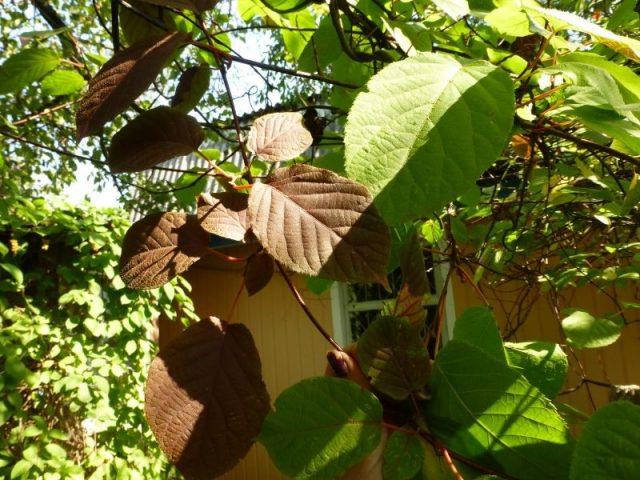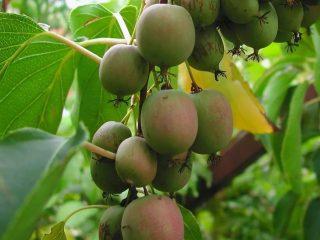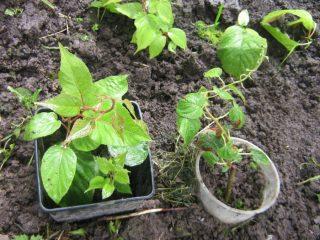Content
Actinidia arguta and kolomikta have certain similarities, but there are important differences between them. To understand which shrub is best to plant on the site, you need to study the characteristics of both types.
General information about actinidia
Actinidia is a perennial woody vine of the Actinidia family. It has reddish-brown thin stems, when grown on a support it reaches about 7 m in length, without it - about 3 m. The leaves of the vine are elliptical, ovate or heart-shaped, usually variegated. In spring, the plates are bright green, but during the flowering period they turn white at the tips, and then turn pink and red.
A peculiarity of the culture is that its buds can only be female or male. The liana bears tasty fruits, but to obtain a harvest, bushes of different sexes must be planted on the site, otherwise pollination will not take place.
What is the difference between actinidia arguta and kolomikta
Actinidia arguta and Actinidia kolomikta are two species from the same family. The plants have strong similarities, but there are also important differences between them.
Appearance
Arguta is a shrub with long vines on average up to 7 m. It has a main trunk up to 15 cm in diameter and side shoots that cling to supports and neighboring plants. The variety branches strongly at a height of 3-5 m, and in adulthood forms a lush crown. The bark on the shoots is usually yellowish-gray.
Arguta leaves are ovoid with a jagged edge and pointed tips. Attached to shoots on dark petioles. The length of the plates reaches 15 cm, in diameter - up to 8 cm. The leaves are rich green, lighter in the lower part, and by autumn they become lemon yellow.

In warm regions, the length of Actinidia arguta vines can reach 30 m
Unlike arguta, actinidia kolomikta produces vines up to only 2-2.5 m long. Its main trunk is thin, covered with cherry-brown, slightly flaky bark. The lateral branches are located close to the ground at the base of the bush, their thickness is about 5 cm.
The leaves of Actinidia kolomikta are elliptical or ovoid, smaller than those of the Argut variety, and in male varieties they are variegated in color. The plates change color only in the upper part, the reverse side remains light green.

Actinidia kolomikta leaves reach 5-13 cm in length
Differences in flowering
Arguta begins to bloom at the end of May. The plant produces snow-white or silver-greenish buds up to 2.5 cm in diameter. The aroma of the flowers is very pleasant, reminiscent of lily of the valley. The decorative period lasts about 2.5 weeks.
The difference between kolomikta is that it blooms later - no earlier than mid-June. Its buds are also white, fragrant and showy.For the first time, flowers appear on the shoots in the 3-5th year of the plant’s life.

Actinidia kolomikta blooms for three weeks
Fruit size and shape
Arguta in the garden, with good care, bears fruit every year. The harvest consists of fairly large berries, reminiscent in shape of both gooseberries and kiwis. The fruits are dark green, occasionally red, reaching 3 cm in length. The pulp is juicy and tender, with a pleasant pineapple taste and aroma.
The distinguishing feature of Actinidia arguta is long-term fruiting - up to three weeks. The berries ripen towards the end of September. Even in unfavorable weather, the fruits remain on the branches for a long time, so you don’t have to rush to collect them.
Actinidia kolomikta ripens from late August to mid-September. Its fruits are narrow and elongated, with dark green skin, on the surface of which there are longitudinal stripes. The pulp tastes like ripe kiwi, and the aroma has pineapple, apple and strawberry notes.

Unlike arguta, actinidia kolomikta has rather small berries - up to 1.5 cm wide and up to 2 cm long
Productivity
To obtain abundant harvests, actinidia arguta is most often planted on the site. It bears up to 30 kg of berries per season, produces fruits with long-term preservation and resistance to shedding.
In contrast, kolomikta produces modest yields. During the season, you can collect 4-7 kg of berries from an adult plant. Harvesting fruits is associated with certain difficulties - they do not hang on the shoots for a long time, but at the same time they ripen unevenly. They cannot be harvested at the same time; the harvest must take several weeks.

Actinidia arguta gives the most abundant harvests in warm regions - up to 50 kg per plant
Frost resistance
An important difference between Actinidia kolomikta is the increased winter hardiness of the plant. The culture's homeland is the Far East; the vine tolerates unfavorable climates well. In winter, it can withstand temperatures down to -45 °C.
In contrast, arguta tolerates temperatures down to an average of -30 °C. The vine can also be grown in areas with harsh climates. But creating winter insulation will have to be given much more attention.
Resistance to pests and diseases
Actinidia kolomikta is of less value in terms of yield, but its positive difference is its increased endurance. The variety not only withstands cold better, but also suffers less often from fungi and pests. Arguta is affected by diseases and insects more often, especially when agricultural practices are violated.
The pests and fungi of the crop varieties are the same. In particular, plants may suffer:
- from white and gray mold;
- from fruit rot;
- from powdery mildew.
Among insects, the leaf beetle is primarily dangerous for both types of actinidia. Sometimes caterpillars appear on the leaves, feeding on juicy greens.

The development of diseases in actinidia is provoked by factors such as waterlogging and thickening of shoots
Lifespan
The lifespan of the kolomikta variety is relatively short. The plant develops and bears fruit on average for 20-30 years. The difference between Actinidia arguta is its higher life expectancy - up to 100 years.
Application
Actinidia kolomikta is most often used for landscaping in summer cottages. The plant does not produce abundant harvests, but among its differences one can note the highly decorative nature of the leaves. The variety is very hardy, can easily withstand severe frosts and does not create any special problems in care.
Arguta varieties are planted both to decorate the site and to obtain a harvest. The liana produces very tasty and healthy berries. The latter are eaten fresh and dried for the winter; compotes and jelly, jam and marshmallows are prepared from them. Berries can be added to wines and liqueurs to improve the taste.
What is better to choose
When choosing a plant, you need to decide, first of all, your goals. It is worth giving preference to kolomikta with its characteristics and differences if the shrub is needed to decorate a summer cottage. The variety is more convenient to grow in regions with harsh climates, since it tolerates frost better and is less likely to suffer from fungi and pests.
If you want to plant actinidia for its juicy, tasty berries, you should opt for argut. The perennial vine produces larger fruits, and its differences include high yield.

Unlike arguta, actinidia kolomikta is not prone to strong growth - it is easier to care for it on the site
Conclusion
Actinidia arguta and kolomikta are equally valued by gardeners. But the first plant is often planted for its fruits, and the second is used to decorate a summer cottage.








